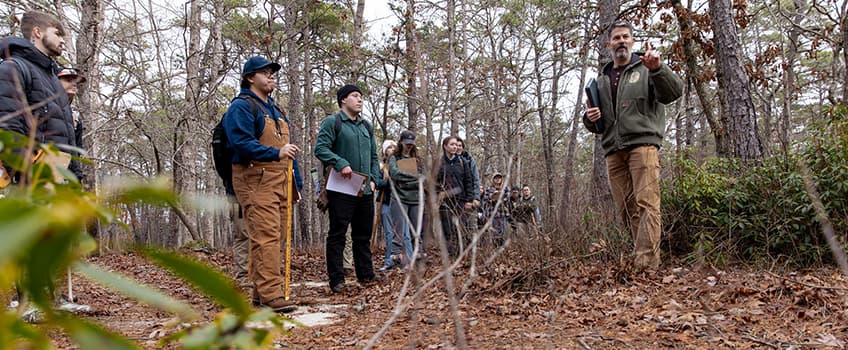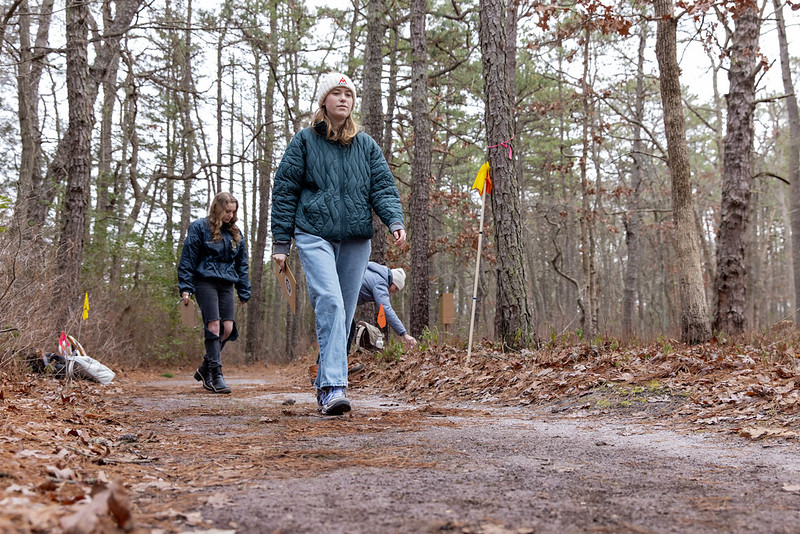Intensifying Wildfire Seasons Ignite a Need to Train Forest Managers

Galloway, N.J. - Morgan Kahn, a junior Environmental Science major from Hammonton, worked as a visitor services assistant at Wharton State Forest this summer when much of the East Coast experienced unhealthy air quality and hazy visibility from wildfire smoke that drifted from Canada.
The record-breaking wildlife season in Canada burned more than 44 million acres in 2023 with hundreds of fires exceeding 24,000 acres, which qualifies them as megafires.
Images captured from space showed smoke surging down the eastern United States and into Europe where it impacted people living thousands of miles from where lightning strikes ignited the flames.
“There were days where it was just too dry for people to light fires for barbecues. If people left fires going, it was our job to put them out, and that happened a lot,” Kahn recalled.
As global climate change brings warmer temperatures and more droughts, managing forests is more imperative than ever. Stockton’s Pinelands campus offers an outdoor classroom where students can be a part of real-world management efforts.
During Matt Olson’s Forest Measurements class, Kahn joined about two dozen students wearing warm clothes and boots built for going off the beaten path.
Olson, an assistant professor of Forestry, led his students through the woods along a plow line created by raking and blowing leaf litter to starve fire of fuel during controlled burns.
The goal of the field outing was to determine the number of paces it takes to travel 66 feet (or one chain) by foot while travelling through varying densities and heights of shrubbery. Foresters can measure tree height using a stick, geometry and their unique number of paces in a chain.
Flags throughout the woods marked the chains students walked while counting their steps.

The class also stopped at a four corners intersection where Olson pointed to plots of land that are burned at different intervals as part of Stockton University’s Forest Management Plan.
Shrubs were visibly shorter and less prevalent in the annual burn site versus areas burned less frequently.
Olson scoured the forest floor for clues to demonstrate how to differentiate species of pine and oak trees. Acorn cups, leaves (on the tree and the ground) and bark are all characteristics to be analyzed during identification.
“With white oak, you see loose-fitting bark, which we describe as being exfoliating bark. It pulls away from the stem of the tree. Some of that bark exfoliation is important for tree roosting bats that will get underneath the bark. When the females are flying around, they leave the pups behind under the bark folds, so big white oaks become important for bat habitat,” Olson said.
Forest Measurements is a hands-on class that “teaches skills that are directly transferable to the workplace. There's a need for people to go out and know how to measure trees and to collect data that tells something about the larger forests. That's essentially what this class is about. Students can go right into a summer job where they could be expected to do this kind of work,” Olson explained.
Drew McClure, an Environmental Science major with a concentration in wildlife management, already works with the New Jersey Division of Fish and Wildlife as a seasonal technician. He wanted to take Olson’s class because forests are one of the many habitats for wildlife and the skills “tie hand in hand” with his work.
“If you’re not able to tell what's in the forest and be able to correctly identify trees, how can you manage wildlife,” he said.
McClure is currently banding black ducks and mallards and tagging the females with GPS backpack trackers.
“We can use GPS and cell phone towers that send us a ping at a chosen interval. We're looking for the nesting habitat that the females are using and the success rates of the nests. We can relay data from here to places like Canada, and scientists in Canada can then go find the nest, count how many eggs are in the nest, and monitor the success rate of the nest,” he explained.
Leah Kowalski, an Environmental Science major from Harvey Cedars, observed a few controlled burns on campus with Olson. Seeing the New Jersey Forest Fire Service working on campus inspired her to take the class, and although fisheries science is her main interest, she’s now exploring forestry as a possible career option.
Kowalski interned with the Jetty Rock Foundation over the summer and worked the Follow the Shell Fridays at the Long Beach Township Field Station in Holgate.
Although Olson’s lifetime is a minuscule sample size in the history of local wildfires, he noted two recent fires that burned thousands of acres in the Pinelands—the Mullica River wildfire of 2022 burned more than 13,000 acres, landing it on the list of New Jersey’s 20 largest wildfires on record, and the Spring Hill wildfire of 2019 burned more than 11,600 acres.
Olson takes students to Wharton State Forest, which he describes as having a "crazy fire history," and shared comments about the perfect storm of conditions that allowed the 2022 fire to spread.
“Now it’s pretty much expected that every year we're going to get a wildfire that could grow to 1,000-plus acres,” Olson said.
This year, Stockton’s plots in the fire interval study, about 20 acres total, will be ignited by the New Jersey Forest Fire Service during the burning season, which is active now through March. Students will be there during the prescribed burns to gain hands-on experience.
Photos and story by Susan Allen
View photos on Flickr








